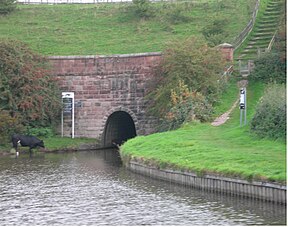Cauldon Canal
| Caldon Canal | |
|---|---|

The southern portal of Leek Tunnel
|
|
| Specifications | |
| Maximum boat length | 72 ft 0 in (21.95 m) |
| Maximum boat beam | 7 ft 0 in (2.13 m) |
| Locks | 17 |
| Status | Navigable |
| Navigation authority | Canal and River Trust |
| History | |
| Original owner | Trent & Mersey Canal Company |
| Date of act | 1776 |
| Date completed | December 1778 |
| Date restored | 1974 |
| Geography | |
| Start point | Froghall |
| End point | Etruria, Stoke-on-Trent |
| Branch(es) | Leek, Uttoxeter Canal |
| Branch of | Trent & Mersey Canal |
The Caldon Canal (or more properly, the Caldon Branch of the Trent & Mersey Canal), opened in 1779, runs 18 miles from Etruria, in Stoke-on-Trent where it leaves the Trent and Mersey Canal at the summit level, to Froghall, Staffordshire. The canal has 17 locks and the 69-metre long Froghall Tunnel.
The first plans by the proprietors of the Trent & Mersey Canal Company to construct a canal from the summit level to Leek were considered in January 1773. This would have been a tub-boat canal, as the boats were designed to carry just 5 tons, and rather than using locks, inclined planes were to be used at points where the level of the canal needed to change. Two more plans were considered, and the third included extra reservoirs which would supply the summit level of the existing main line. At a similar time, an independent company was planning a link to Leek, but the Trent & Mersey managed to block this. Having secured contracts with several owners of limestone quarries in the Caldon Low area, the company sought an Act of Parliament to authorise construction of the new works, which it obtained in May 1776.
The Act enabled the proprietors to borrow £25,000 to fund the construction, which was completed in December 1778. Initially, there were 16 locks, eight rising from Etruria to the start of the summit at Stockton, and eight falling from the end of the summit to Froghall. 1.5 miles (2.4 km) of the canal followed the bed of the river Churnet near Consall. The company could also build railways to the quarries, and the first, which ran from Froghall across Shirley Common towards the quarries opened at the same time as the canal, but was not a success. A second Act of Parliament was obtained in 1783 to authorise a new tramway, and to extend the canal by 530 yards (480 m), which included the Froghall tunnel. The tramway was 3.1 miles (5.0 km) long, and was funded out of revenue, as the Act did not authorise the raising of additional capital.
Traffic on the Trent and Mersey main line was such that it suffered from water shortage in dry periods, and water levels on the Caldon branch were often too low at such times, as the water was used to keep the main line moving. In 1796, the company wanted to build a reservoir at Rudyard, to improve the situation, and a branch to Leek was included in the Bill, as it was the only way to obtain the consent of the Leek authorities and landowners for the reservoir. The Bill was defeated in Parliament, after which the Peak Forest Canal Company proposed to build a branch of their canal from Marple to Leek, and on to join the Caldon branch. It would also have included a reservoir at Rudyard, but the plan was short-lived, as the Trent and Mersey succeeded in getting their bill passed when they submitted it to Parliament for a second time in 1797. To ensure that the water from Rudyard could be used to supply the main line, the Leek branch had to join the top level of the Caldon branch, and so the original route with the three Park Lane locks was closed and a new route built, with a three-lock staircase between the junction and the old line of the canal. This was altered again in 1841 to the present arrangement, where the canal to Froghall passes under an aqueduct on the Leek branch, and three separate locks at Hollinhurst raise the old line up to the summit level.
...
Wikipedia
